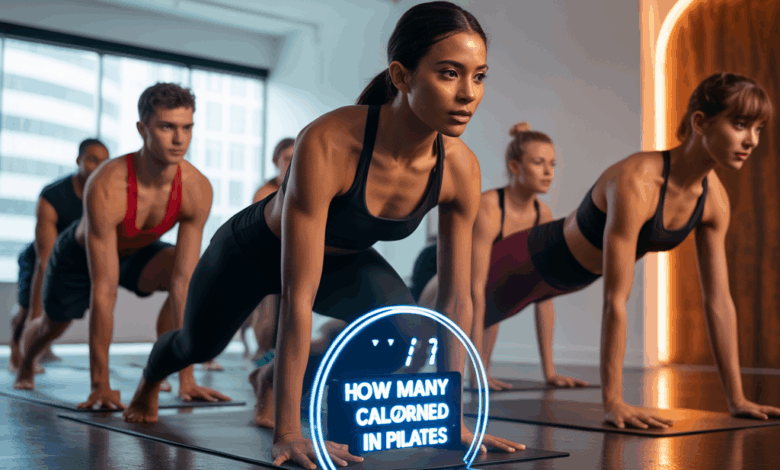How Many Calories Burn In Pilates

Ever left a Pilates class wondering, “Did that 50-minute session actually burn enough calories to count?” You’re not alone. Whether you’re aiming for weight loss, better posture, or stronger core muscles, understanding how many calories burn in Pilates helps you plan workouts and set realistic goals.
Quick answer: Calories burned in Pilates depend on intensity and you
Pilates calorie burn varies widely. A gentle mat class will burn significantly fewer calories than a high-energy reformer or power Pilates session. Factors like body weight, workout intensity, tempo, and whether you add resistance or cardio intervals all influence the final number.
Estimated calorie ranges (real-world examples)
- Light mat Pilates (beginner pace, gentle stretching): ~2.5–3.0 METs
- Moderate Pilates (standard class, steady pace): ~3.0–4.0 METs
- Vigorous reformer or power Pilates (fast tempo, added resistance): ~4.0–6.0 METs
Using the MET formula (kcal/min = MET × 3.5 × weight(kg) / 200), here are approximate calorie burns per 30 minutes:
- 125 lb (57 kg): 70–170 kcal
- 155 lb (70 kg): 85–210 kcal
- 185 lb (84 kg): 100–250 kcal
So, a 155 lb person doing a moderate 45-minute Pilates class might burn roughly 130–315 calories depending on intensity and equipment.
What influences how many calories burn in Pilates?
Not all Pilates classes are created equal. Here are the key variables:
- Intensity and tempo — Faster, more repetitions increase heart rate and calorie demand.
- Type of Pilates — Mat, reformer, Cadillac, or equipment-based classes change resistance and workload.
- Your weight and body composition — Heavier people burn more calories for the same activity; more muscle increases resting calorie burn.
- Class length and rest periods — Longer sessions or fewer rest breaks mean more calories burned.
- Added elements — Light weights, resistance bands, and cardio bursts raise energy expenditure.
Example classes and expected burn
- Gentle rehab-style mat Pilates (30 min): ~60–90 kcal
- Classic mat Pilates (45–60 min): ~120–260 kcal
- Reformer or power Pilates (45–60 min): ~200–400 kcal
How to maximize calorie burn in Pilates (without losing form)
Pilates is about control and precision — you don’t have to rush to make it effective. Use these practical tips to increase energy expenditure while keeping form:
- Shorten rest times between exercises to maintain an elevated heart rate.
- Add light hand weights or ankle weights for extra resistance.
- Incorporate standing balance and compound movements that recruit more muscle groups.
- Try interval-style Pilates: 30–60 seconds of higher intensity followed by 30 seconds of controlled recovery.
- Increase class frequency: consistency is key for long-term calorie balance and body composition changes.
Sample “calorie-friendly” Pilates mini-session (20 minutes)
- Warm-up: 3 minutes dynamic breathing + pelvic tilts
- Power block (3 rounds): 45 sec standing leg series → 15 sec rest
- Core circuit (3 rounds): 40 sec single-leg stretch → 20 sec plank variations
- Full-body finisher: 2 minutes reformer-style sprints or fast controlled squats
- Cool-down: 2 minutes stretching and breathing
This type of condensed, higher-tempo session can significantly raise calories burned compared to a slow, restorative class.
Benefits beyond calorie counting
Focusing only on how many calories burn in Pilates misses important benefits. Pilates builds core strength, improves posture, reduces injury risk, enhances flexibility, and supports mobility — all of which contribute to a more active daily life and better long-term metabolic health.
How Pilates supports fat loss and fitness goals
- Improved posture and core strength help you move better during cardio and strength training, making other workouts more effective.
- Muscle development increases resting metabolic rate — you’ll burn more calories at rest over time.
- Low-impact nature allows for more frequent training with less joint stress, aiding consistency.
Combining Pilates with other training for optimal calorie burn
For faster weight-loss results or higher calorie expenditure, combine Pilates with cardio and strength sessions. For example:
- 3 Pilates classes per week + 2 moderate cardio sessions (brisk walk, bike) + 1 strength training session
- Swap one Pilates session for a HIIT workout if you want a higher short-term calorie spike
- Use Pilates as recovery-focused strength work between heavier gym days
To support these workouts nutritionally, check our nutrition guides for meal timing and macro tips.
Practical lifestyle tips to increase overall calorie burn
- Move more outside of workouts: take walking breaks, opt for stairs, and stand periodically during the day.
- Prioritize sleep — poor sleep reduces workout performance and raises appetite.
- Eat protein with each meal to support muscle repair and satiety.
- Track progress with a mix of scale, measurements, and performance markers (e.g., more reps, less fatigue).
For structured plans that blend Pilates with cardio and strength, explore our workout routines and wellness tips pages.
Frequently Asked Questions
Yes, Pilates can contribute to weight loss when combined with a calorie-controlled diet and regular activity. It builds lean muscle, improves posture, and increases daily movement capacity — all supporting fat loss — but adding cardio or higher-intensity sessions will speed results.
Generally, reformer and equipment-based Pilates can burn more calories because they allow for added resistance, faster tempo, and more full-body movements. The actual difference depends on class intensity and your personal effort.
Aim for 2–4 Pilates sessions per week for improved strength and mobility. Combine with 1–3 cardio or strength sessions if your primary goal is calorie burn or weight loss. Consistency and progressive challenge are key.
Conclusion — Know the numbers, enjoy the benefits
So how many calories burn in Pilates? It depends — expect roughly 70–250 calories per 30 minutes based on intensity and body weight. More vigorous reformer or power Pilates sessions can push that higher. But don’t forget: Pilates delivers major non-calorie benefits (strength, posture, flexibility) that improve overall fitness and long-term metabolic health.
Ready to optimize your routine? Try a mix of mat and reformer classes, add short high-intensity blocks, and pair your workouts with smart nutrition. Visit our workout routines and nutrition guides to build a plan that fits your goals — and sign up for a class this week to feel the difference.





